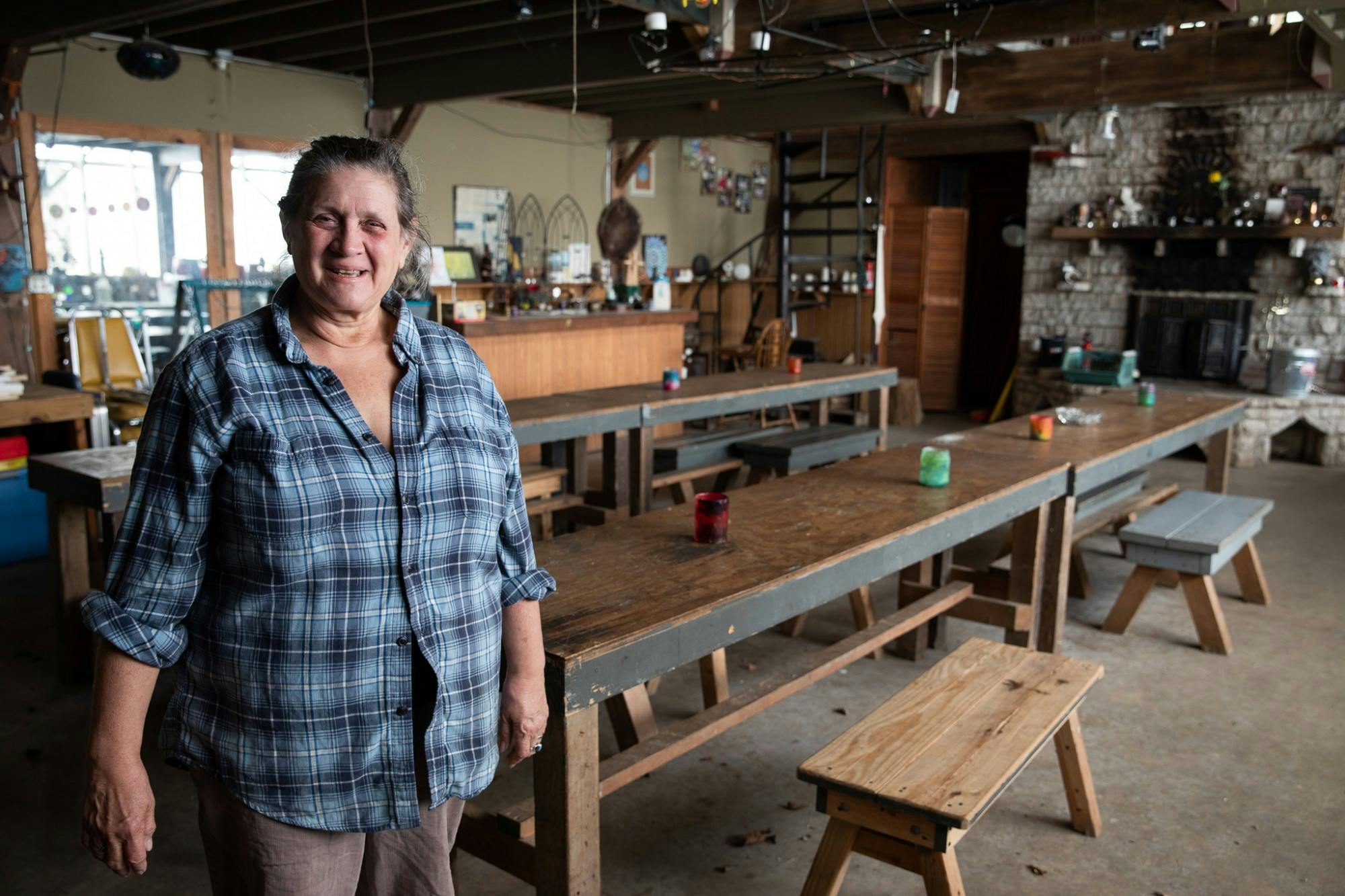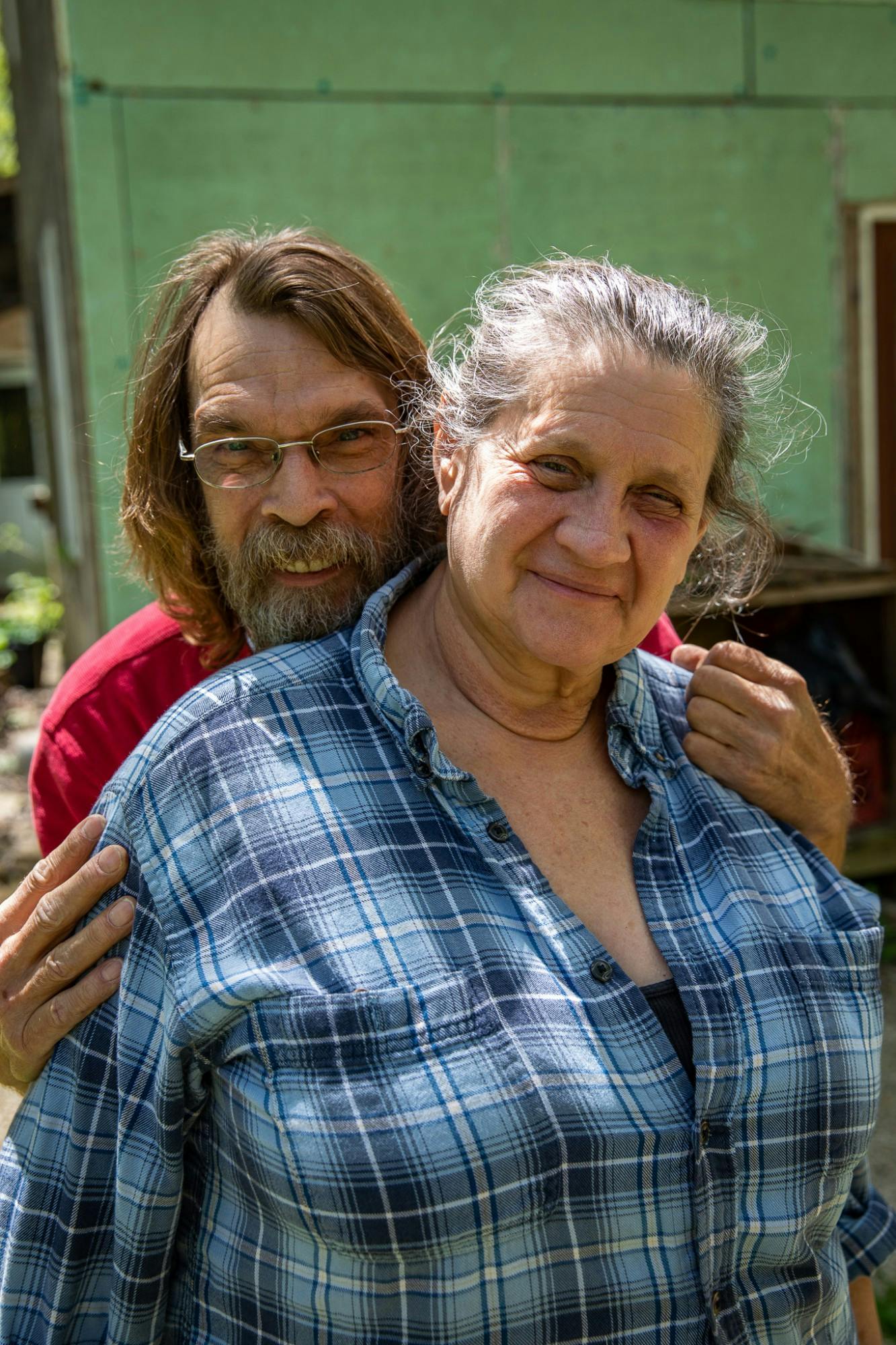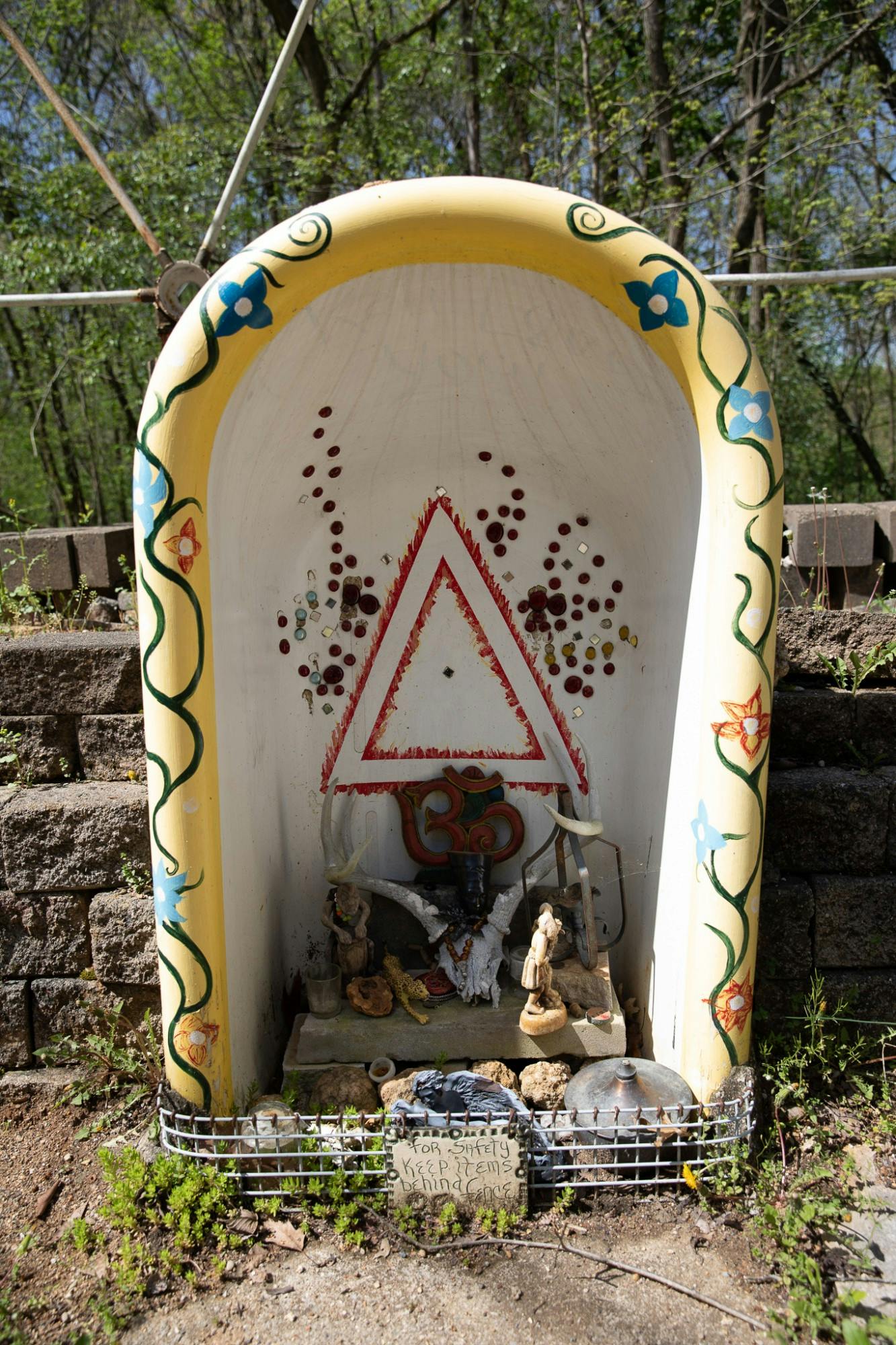Just 18 miles south of Bloomington, off a county road, past the unincorporated community of Judah and hillsides dotted with cattle, a nondescript gravel road leads into the forest.
When the oak and beech trees lining the drive open to a clearing, they reveal a place that could be many things — but is definitely not another rural Indiana farm.
In curling yellow font, a sign reads “Lothlorien Nature Sanctuary.” Beyond the entrance, a mishmash of small buildings lies nestled among the trees. A wooden shed here, a tent or two there, a half-finished house over here.
Drive slow, another sign warns. “Elves At Play.”
Spots of color peek out amid the sprawling green springtime vegetation to show evidence of human — or perhaps elven — activity. Neon pink fairy wings are tied to a tree. Rainbow mosaic benches line pathways. Teapots dangle from fences.
The sight is more reminiscent of a Lord of the Rings movie set than a typical Indiana dwelling, but it’s not fictional. It’s the residence of members of the Elvin Holy Order of Mother Earth — also called HOME.
The Elvin HOME organization operates 120 acres of forested land in Southern Indiana called the Lothlorien Nature Sanctuary, which was created almost four decades ago as a nature preserve, residential community, spiritual retreat and festival site.
The sanctuary is named after Lothlórien, an ancient forest and the fairest of elven realms in J.R.R. Tolkien’s “Lord of the Rings” novels.
The community, with all its mystique and fantasy, is a surprisingly human undertaking. More than an act of theater, it’s one group of humans' attempt to find joy and create meaning in an ordinary forest they’ve deemed extraordinary.
And maybe, while they’re at it, to serve as an example to the society outside its borders.
”Protectors of the forest”
It’s a sleepy spring morning at Lothlorien. No elven songs or rhythmic chants can be heard, just the nostalgic calm of leaves rustling in the wind. Trees cocoon the community from any sounds of traffic on the nearby highway.
The echo of birds chirping is the only sound Conney Freese-Posthuma hears as she meanders along one of Lothlorien’s hiking trails.
“I try to stop thinking and just be in the woods,” she said, pausing to pull invasive garlic mustard creeping onto the trail. “It’s very peaceful. I’m checking in with the trees, listening and looking at what’s growing and what wildflowers are blooming.”
Freese-Posthuma’s been wandering these woods for over 30 years. She and her husband helped found Lothlorien in 1987 and are one of a small handful of members who reside permanently at the sanctuary.
She said the rest of the group’s more than 400 members camp at Lothlorien for short periods of time or visit for gatherings like full moon celebrations. Members can camp for free in exchange for volunteer hours helping maintain the sanctuary, Freese-Posthuma said.
Something new appears with every turn on her walk through Lothlorien — a shrine at the base of a tree, a sculpture of twigs in the shape of a dragon, a labyrinth of rocks for meditation. There’s composting toilets, a wood-fire boiler for hot showers and a few small buildings with solar panels.

A wooden archway draped with butterfly windchimes leads Freese-Posthuma to a small footpath. She follows the path, pointing out a patch of bluebell flowers on the forest floor.
In the middle of the flowers grows a black cherry tree. It’s called the Heart Tree, Freese-Posthuma said, because it symbolizes the “heart of the forest” and is a way to make sure the energy of the forest stays near their community.
Freese-Posthuma said Lothlorien’s tract of forested hills used to be owned by a farm. After they purchased the land, she said, the community set out to improve the ecosystem’s health by clearing invasive species and protecting the forest from development.
Indiana’s “elves” have received international recognition for their community-based approach to forest management. The International Forestry Resources and Institutions research program and Indiana University’s Ostrom Workshop chose Lothlorien as a site for research on local governance of forests.
Researchers, including Nobel Prize-winner Elinor Ostrom, visited Lothlorien multiple times between 1997 and 2011 to study the social, institutional and biological factors of the forested community. A 2011 visit found the forest matured under Lothlorien’s protection, indicating improved forest health. It also found the forest captured about 36% more carbon from the air in 2011 compared to 1997, meaning the forest is helping reduce greenhouse gases in the atmosphere.
Freese-Posthuma said she’s motivated to protect Lothlorien’s forest because she feels a spiritual connection with nature.
“I believe everything is alive and has value,” she said. “Everything is connected. There’s divinity in everything here: the trees, plants, critters.”
The legal organization behind Lothlorien, Elvin HOME, is incorporated as a federal 501(c)3 religious organization, but Lothlorien does not follow any one religion and welcomes members of all backgrounds. What members share in their beliefs is a reverence for nature.
That’s why Lothlorien members refer to themselves as “elves,” Freese-Posthuma said. They don’t view themselves as elves in a literal sense; rather, it’s a term that embodies the spirit of caring for the land.
“Some days I feel like an elf,” she said. “Elves are protectors of the forest.”
Protecting the forest was one of the key goals of Lothlorien when the group purchased a tract of land in 1987, Freese-Posthuma said. Since then, it’s been a sanctuary for both nature and people — especially those who’ve struggled to find community elsewhere.
“Mad dash”
Freese-Posthuma finishes her morning walk and returns to her house — the only one in Lothlorien. The two story building with unfinished siding seems crooked in a charming way, though maybe it’s just a trick of the forest lighting.
A scraggly cat named Posey immediately perches on her shoulder. Freese-Posthuma’s husband, Michael Posthuma, is equally quick to greet her.

“Some weeks I’m out here so much I forget what day it is,” Posthuma said, leaning on his wife’s other shoulder. “I kind of drift off into it. This is like heaven. It's the one spot where you can get away from the world for a moment or two.”
Posthuma said he and a friend got the idea for Lothlorien in the early 1980s. They dreamed of a communal gathering space where no one individual owned the land.
So, when a property in rural Indiana went up for sale in 1987, Posthuma said the group bought it and named it “Lothlorien Nature Sanctuary.” Members who joined would become shared owners.
Posthuma said he made a “mad dash” to Lothlorien with nothing but $60 and a tank of gas. It was a lifestyle choice, he said, not a financial investment. The group had $75 to its name and didn’t own a push mower, so they had to use shears to cut the property’s overgrown grass.
“I thought Lothlorien would last maybe six months,” he recalled. “It still amazes me sometimes where we are now from where we started.”
Lothlorien hosted its first Elf Fest, an annual festival to make money to sustain its operations, in 1989. Posthuma said there were 53 attendees at the first Elf Fest. When attendance peaked, a few years before COVID-19, Elf Fest attracted more than 700 people to the Southern Indiana woods.
Lothlorien is less sleepy on festival weekends. When the sun dips into the valley on festival nights, attendees ignite a fire in the middle of a massive metal-framed dome: the “Thunder Dome.” Drum circles and dancing commence inside. The noise echoes across the valley, Freese-Posthuma said.
When nighttime drumming rituals and people who refer to themselves as “elves” descended upon rural Indiana, Freese-Posthuma said Lothlorien was met with initial skepticism and resistance from neighbors in the surrounding community.
“They said we’re weird and lazy,” Freese-Posthuma said. “We attract a lot of people who maybe don't quite fit into the mainstream everywhere else.”
Freese-Posthuma said they used to receive noise complaints from neighbors and get police called on Elf Fest. A local newspaper once called Lothlorien gatherings “satanic rites” and quoted police officers describing members as devil worshippers, according to the book “An Unreal Estate,” written about Lothlorien.
“A big experiment”
Across the road from Freese-Posthuma’s house, a man named Bone resides in the woods.
Bone moved to Lothlorien in 1999, where he’s lived ever since. Bone, who said he only goes by that name, is the acting president of Elvin HOME.
Bone is less interested in drum circles and shrines. He doesn’t consider himself spiritual or identify as an elf.
“No, I am not delusional,” he said to queries of his elven-ness. “I do not think I’m an elf.”
Fitting to his name, the man wears earrings carved out of bone. His individualism is evident in everything from his sleeve tattoos to the fact that on his hip lies a protective case he built for his $40 cellphone so he never has to buy another one.
Bone moved to Lothlorien after a childhood raised by a Christian preacher. He said he wanted somewhere without the constraints of an “oppressive religion” where he could live freely in nature away from city life.
“Bloomington is hell on earth,” he said. “My main thing I need is a beautiful forest.”
Bone said he doesn't have a religion, only his connection to the natural world. Many members are drawn to Lothlorien’s acceptance of religious beliefs that don’t fit into the mainstream. Members range from Neo-Pagan and Wiccan to Christian and atheist, he said.
By accepting people of all walks of life and living sustainably in the wilderness, Bone said he thinks Lothlorien is radically different from modern society. To him, Lothlorien should serve as a model to inspire society to live more sustainably and address issues like climate change.
“It’s a big experiment, something different,” he said. “This place has given me hope for just the possibility of a different way for us to exist.”
This introduces a dilemma facing alternative communities like Lothlorien: whether or not their impact remains isolated within the bounds of their community, or if by living unconventionally they can inspire the world outside.
Many members seek Lothlorien for the individual, religious and creative freedom that solitude provides, but they aren’t isolated from the outside world. The elves are easy to contact. They’re on Facebook and have an “Ask An Elf Hotline.” “Lothlorien Nature Sanctuary” is a location on Google Maps. Members work other jobs outside the sanctuary.

Bone, for one, wants the world to know about Lothlorien.
“I could wander off into the wilderness and be content, but my conscience tells me I have to do something to try to fix the problem,” he said. “I think Lothlorien is needed here to open minds of other people to a different way of life that’s more sustainable.”
For Bone’s vision of awareness to be spread, the sanctuary needs to survive into the future.
Bone said he could stay here the rest of his life. Posthuma and Freese-Posthuma aren’t going anywhere. But as they age, the number of younger members joining Lothlorien isn’t keeping up with what Posthuma describes as the “wild ‘90s.”
It’s a small crowd at Lothlorien on this early May day, just enough to sit around Freese-Posthuma’s patio table. Spring weekends are volunteer work days to take care of the sanctuary, but only a few members trickled in by midafternoon. Festivals are more and more popular, but the number of volunteers committed to tending the land is decreasing.
“Lothlorien needs help,” Bone said. “Mother Nature needs more people to go out into the world to care about our planet.”
When leaving Lothlorien, the gravel road turns to asphalt, turns to highway, turns to interstate. Glimmers of trinkets in trees turn to glimmers of stoplights. A business with the 10 Commandments painted on its side passes by the window.
The striking contrast between Lothlorien and its surrounding community may appear like a dichotomy — one versus the other. But the two are intertwined. The patch of elven woods is a small part of a larger human forest.
After all, the only “elves” to be found at Lothlorien are humans.
Lotherien is a community founded on the ideals of a fantasy realm, but, at least to a handful of members on one quiet Sunday morning, they don’t think that makes it any less realistic.
Lothlorien is a response to, not a rejection of, society. Inside the woods lives a beacon of hope for humanity, Bone said.
If a tree falls in the forest and no one is around to hear it, does it make a sound? The elves make noise protecting the forest, and their hope is maybe someone will hear it.




